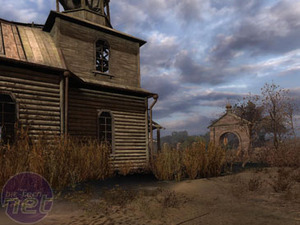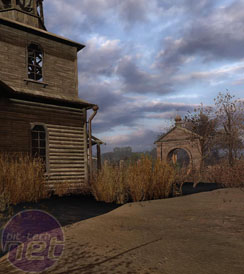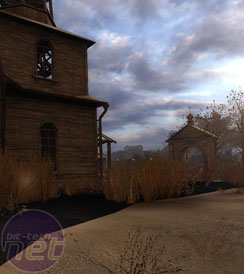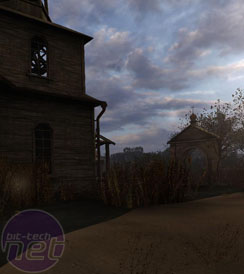
The Patch
The real issue at hand here though is the patch and whether it’s made the game playable or not for us. Is it still more likely to crash than a narcoleptic rally driver, or is it finally as stable and unmoving as our salaries?Simply put, it’s the latter.
Originally the game was wildly unpredictable for us on not just one but three separate systems. We tested the game on the standard gaming machine we use for reviewing every game, we tried it on one of our ATI test-rigs and Richard even took it home and tortured himself by trying to get it running there.
For each system the results were different, but similar. We weren’t just getting crashes in certain easily avoidable places or in repeatable conditions, we were getting constant and randomly placed errors and crashes. Bluescreens would pop up faster than we could reboot them away and NPCs would randomly disappear or turn up dead as apparent victims of the anti-playtesting murderer.


S.T.A.L.K.E.R.: Clear Sky on Maximum settings with DX10 Enhanced Lighting (left) and High settings with DX9 Enhanced Lighting (right), click to enlarge
With the latest version though the game is as stable as we could hope, with not a single crash striking down either of the systems we tried the game on. Whether or not the game should ever really have needed patching, Clear Sky has definitely benefitted from the after-market care that the developer has given it – if only GSC Game World had made sure it was this stable when it was originally put on shelves!
Performance however is still going to be a little bit of an issue for most gamers however, that’s the bad news. The X-ray engine that the game runs on is quite demanding in its new optimised form and players may struggle to get decent framerates at the highest detail levels. On maximum quality you’ll need to have very beefy DirectX 10 hardware to cope with the fantastic looking light effects.
Above we’ve included a quick recap on the graphical presets just in case something subtle has changed since the patch (it hasn’t), but if you want to check out a more through break down of how the graphics then you can check out our original S.T.A.L.K.E.R.: Clear Sky review. In the previous review, we covered all the graphics settings in much more detail.



S.T.A.L.K.E.R.: Clear Sky on Medium settings with Full Dynamic Lighting (left), Low settings with Object Dynamic Lighting (centre) and Minimum settings with Static Lighting (right), click to enlarge
Here though you can see the difference between the settings though. The gap between the two pictures of the game on the highest settings and the other pictures below really is quite dramatic. If you examine the larger images, which we’ve kindly labelled, then you’ll notice how not only the quality of the lighting changes, but also the smoothness of the waterline and the overall crispness of the textures.
Performance however is still a little unpredictable, it has to be said. When we first booted the game up we put our standard gaming system (Core 2 Duo X6800, 3GB RAM, Vista 32-bit, GeForce GTX 280) on the highest settings with DX10 lighting and were barely able to squeeze 20 fps out of Clear Sky. Returning to the game later however we used the same hardware in a different level to get around 40 fps on average.
Do bear in mind though that even though the game performance is still a little flaky, we’d still recommend that players can run the game on Medium settings as a minimum. Clear Sky is a hugely atmospheric game at points, especially when you get underground and the mutants start scuffling around you like pigs hunting for truffles.
The shadow and lighting effects are truly impressive and used to great effect, so you’d be doing yourself an injustice if didn’t run the game with them included.

MSI MPG Velox 100R Chassis Review
October 14 2021 | 15:04









Want to comment? Please log in.